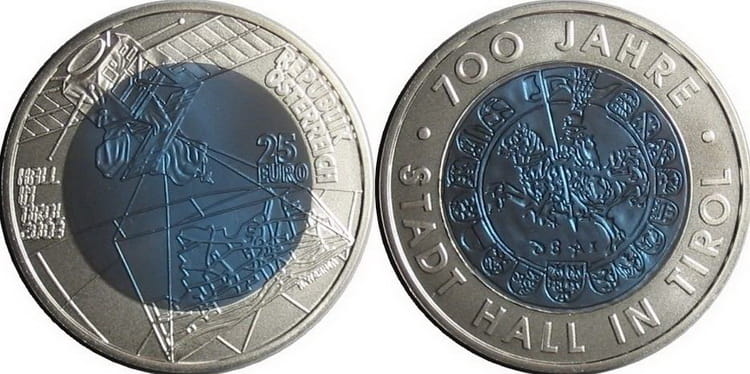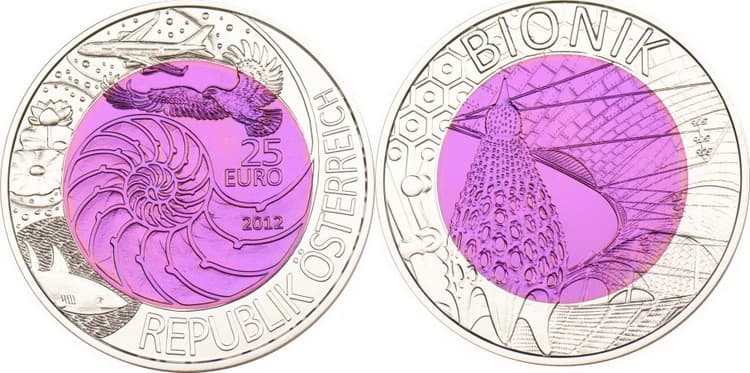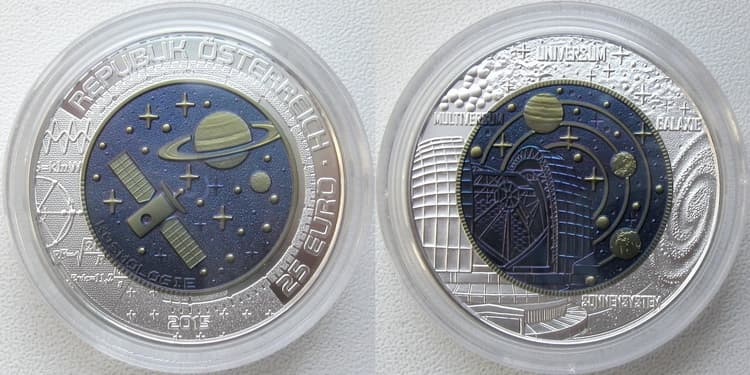
25 Austrian euros is a series of collectible coins, which is currently being issued by the Austrian Mint. The first official coin of this denomination was issued in 2002 when Austria accepted euro and superseded shilling. The first euro coin of this denomination became a part of the series of gold and silver collectible coins dedicated to the Vienna Philharmonic. Since then, the popularity of the series has increased, and coins continue to be minted, being sold to numerous collectors around the world. Subsequently, in 2003, Austria launched a new series of bimetallic 25 euro coins, which exists to this day, entering the market at the beginning of each year.
«Vienna Philharmonic» series
Production: Austrian Mint
Design: Thomas Pesendorfer
Metal: gold (Au 999)
Weight: 7.776 g
Diameter: 22 mm
Thickness: 1.2 mm
Circulation: 2002/40,807; 2003/34,019; 2004/32,449; 2005/32,817; 2006/29,609; 2007/34,631; 2008/97,100; 2009/172,000; 2010/84,900.
The first Austrian coin with a face value of 25 euros was issued in 2002 as a part of the popular Vienna Philharmonic series. It replaced the previous coin with 500 shillings face value of the same composition and size. Since then, this coin is issued annually, along with coins of 1, 5, 10, 50, and 100 euro denominations. Like other coins of the series, it was designed by Austrian sculptor Thomas Pesendorfer and minted at the mint of Vienna. The coin consists of one-fourth of an ounce of gold with a fineness of 999 (exact composition: 99.99% gold and 0.1% copper).
Obverse: the pipe organ from the concert hall Musikverein in Vienna, owned by the Vienna Philharmonic Orchestra; name of the country «REPUBLIK ÖSTERREICH»; gold purity index «¼ UNZE gold 999.9»; year of minting; denomination.
Reverse: instruments of the Vienna Philharmonic Orchestra: a cello, four violins, a Vienna horn, a bassoon and a harp; inscription «WIENER PHILHARMONIKER»

Coin “700 years of Hall in Tyrol”
Production: Austrian Mint
Design: Helmut Andexlinger and Herbert Weiner
Metal: Nb 998 and Ag 900
Weight: 17.15 g
Diameter: 34 mm
Edge: plain
Circulation: 50,000 (Special UNC)
Obverse: satellite directed to the map of the city; denomination «25 euro»; inscription «HALL IN TIROL 2003»; name of the country «REPUBLIK ÖSTERREICH».
Reverse: symbolic image of the hall of the Tyrol Museum; inscriptions «700 JAHRE» and «STADT HALL IN TIROL».

Coin “The 150th Anniversary of the Semmering Railway”
Production: Austrian Mint
Design: Thomas Pessendorfer and Herbert Weiner
Metal: Ag 900 and Nb 998
Weight: 17.15 g
Diameter: 34 mm
Edge: plain
Circulation: 125,000 (Special UNC); 275,000 (UNC)
Obverse: two locomotives, modern and antique one, symbolizing the technical progress in the production of locomotives since the moment of completion of the Semmering Railway construction; high-performance electric locomotive “Taurus” built by Siemens AG; the first functional Alpine locomotive “Engerth” under it; year of minting.
Reverse: steam engine coming out from a tunnel, and crossing a famous viaduct on the Semmering Railway.

Coin “European Satellite Navigation”
Production: Austrian Mint
Design: Thomas Pesendorfer and Herbert Weiner
Metal: Ag 900 and Nb 998
Weight: 17.15 g
Diameter: 34 mm
Edge: plain
Circulation: 65,000 (Special UNC)
Obverse: inscription «Position der Münze Österreich»; approximate coordinates of the building of the Austrian Mint: «NÖRDLICHE BREITE 48° 12′ 12″, 3» and «ÖSTLICH VON GREENWICH 16° 22′ 58»; 16-point wind rose.
Reverse: the Earth surrounded by satellites; five vehicles: an airplane, two trucks, a train and a container ship.

Coin “Austrian Aviation”
Production: Austrian Mint
Design: Thomas Pesendorfer and Herbert Weiner
Metal: Ag 900 and Nb 998
Weight: 16.5 g
Diameter: 34 mm
Edge: plain
Circulation: 65,000 (Special UNC)
Obverse: cockpit, or navigation room of a modern passenger aircraft; inscription «H WÄHNER».
Reverse: «Etricht Taube», a monoplane designed by the Austrian pilot Hugo Etricht (1879-1967) in 1910; an image of “Zanonia”, a glider designed by Etricht in 1903; Etrichs’s signature; initials of Thomas Pesendorfer.

Coin “Fascination light”
Production: Austrian Mint
Design: Herbert Weiner
Metal: Ag 900 and Nb 998
Weight: 16.5 g
Diameter: 34 mm
Edge: plain
Circulation: 65,000 (Special UNC)
Obverse: man on a ladder, installing a street gas lamp in front of the Musikverein concert hall in Vienna.
Reverse: portrait of Carl Auer von Welsbach and sun on the niobium part of a coin; images of several types of lighting, including gas lighting, various incandescent light bulbs, neon lights, LEDs and a flashlight on a silver part of a coin.

Coin “International Year of Astronomy”
Production: Austrian Mint
Design: Herbert Weiner
Metal: Ag 900 and Nb 998
Weight: 16.5 g
Diameter: 34 mm
Edge: plain
Circulation: 65,000 (Special UNC)
Obverse: dark side of Moon; inscription «rückseite des mondes»; Weiners’s signature «H WÄHNER».
Reverse: portrait of Galileo Galilei; Galilean telescope and one of Galileo’s first drawings of the surface of the moon; space telescope; stylized sun; image of Saturn; radio telescope; the telescope of Isaac Newton; the observatory in Kremsmunster abbey; modern telescope; inscription «jahr der astronomie», which translates as “the year of astronomy”.

Coin “Renewable Energy”
Production: Austrian Mint
Design: Helmut Andexlinger
Metal: Ag 900 and Nb 998
Weight: 16.5 g
Diameter: 34 mm
Edge: plain
Circulation: 65,000 (Special UNC)
Obverse: tree, which symbolizes all vegetation on Earth; four classical elements – air, earth, fire and water around the tree; water flow on silver part of a coin; wind flutters tree leaves to earth on the niobium part of a coin; sun symbolizes fire, since its rays produce natural heat; earth is represented by the roots of a tree that helps it to absorb the necessary nutrients and water from the earth.
Reverse: ground on the background; water turbine that produces hydroelectricity from the kinetic energy of water; wind turbine, which transforms the kinetic energy of wind; solar panels that absorb the thermal energy of the sun, generating electricity.

Coin «Robotik»
Production: Austrian Mint
Design: Helmut Andexlinger and ГербертВайнер (на сайте монетного двора вторым дизайнером указан Thomas Pesendorfer)
Metal: Ag 900 and Nb 998
Weight: 16.5 g
Diameter: 34 mm
Edge: plain
Circulation: 65,000 (Special UNC)
Obverse: robotic version of the Vitruvian man, created by Leonardo da Vinci (1452-1519) in 1490; denomination «25 euro»; three large gear, symbolizing mechanical aspects of robotics; binary numbers, symbolizing electronics and calculations that are involved in robotics.
Reverse: Mountain landscape of the planet Mars and the star-filled sky above it; robot rover «ExoMars», developed by the European Space Agency (ЕSА).

Coin “Bionik”
Production: Austrian Mint
Design: Thomas Pesendorfer and Herbert Weiner
Metal: Ag 900 and Nb 998
Weight: 16.5 g
Diameter: 34 mm
Edge: plain
Circulation: 65,000 (Special UNC)
Obverse: chambered shell of the Nautilus (Nautilus pompilius), which has been inspiring many architects to create the famous buildings for a long time; inscription «2012»; denomination.
Reverse: radiolarian rays, which inspired the Spanish architect Antonio Gaudi; Olympic Stadium in Munich, the roof of which was designed due to the discoveries in the field of bionics.

«Tunnel Construction» coin
Production: Austrian Mint
Design: Herbert Weiner
Metal: Ag 900 and Nb 998
Weight: 16.5 g
Diameter: 34 mm
Edge: plain
Circulation: 65,000 (Special UNC)
Obverse: modern machine designed for tunnel construction; mountain, through which machine pierces.
Reverse: one of the many alpine tunnels located in Austria; schematically depicted strengthening the walls of the early Alpine tunnel; worker punching a rock with a pneumatic hammer.

Coin «Evolution»
Production: Austrian Mint
Design: Helmut Andexlinger
Metal: Ag 900 and Nb 998
Weight: 16.5 g
Diameter: 34 mm
Edge: plain
Circulation: 65,000 (Special UNC)
Obverse: DNA chain; glass containing a bubbling liquid; microscope; caduceus with one snake and no wings; inscription “DNA” under the caduceus; inscription “RNA” (ribonucleic acid) on the right side of the microscope; inscription “evolution”.
Reverse: round frame with mushroom, flower, fish, and frog; toucan and an incomplete theoretical evolutionary process of man: a monkey, primitive member of the genus Homo, modern man.

Coin «Cosmology»
Production: Austrian Mint
Design: Helmut Andexlinger
Metal: Ag 900 and Nb 998
Weight: 16.5 g
Diameter: 34 mm
Edge: plain
Circulation: 65,000 (Special UNC)
Obverse: the Rosetta space probe, the first spacecraft put into the orbit of a comet; Saturn with its rings; several stars and other planets on the background; handful of stars and planets merge with the blue background.
Reverse: European super-large telescope (E-ELT); astronomical observatory built in the Atacama Desert in northern Chile, which is planned to be completed in 2022; illustrations of Venus, Earth and Mars in their orbits, along with the orbit of Mercury, which is almost entirely hidden behind the image of the telescope; several stars and small planets; all of the above items are in yellow color except for the telescope.

Cost of the coins
Now, the Austrian mint offers only a few of the presented coins on the market, most of them have gone to private collections. The price of one copy can be from 56 to 145 euros, depending on the trading platform and the country of sale.
Comments
No commens yet.